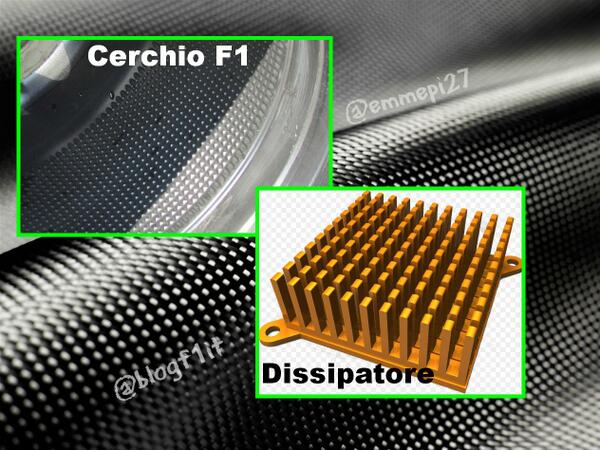Great spot, Mario. Definitely a heat-sink design for temp management.emmepi27 wrote:Difference about inner surface of front rims between Monza and Suzuka
https://pbs.twimg.com/media/BWm-CMiCQAAWYkp.jpg
- Login or Register
No account yet? Sign up
Great spot, Mario. Definitely a heat-sink design for temp management.emmepi27 wrote:Difference about inner surface of front rims between Monza and Suzuka
https://pbs.twimg.com/media/BWm-CMiCQAAWYkp.jpg
Thanks!Kiril Varbanov wrote:Great spot, Mario. Definitely a heat-sink design for temp management.emmepi27 wrote:Difference about inner surface of front rims between Monza and Suzuka
https://pbs.twimg.com/media/BWm-CMiCQAAWYkp.jpg
It's always the front wheel!Aaronque wrote:Is that a new wheels or is that front and rear wheels?
It's very difficult to say if the solution put in or put out heat in the tyre by the rim; but i'm pretty sure that it uniform heat on rim's surface (and, consequently, to the air in the tyre)SectorOne wrote:So what does it do? Help cool or help keep heat in the tires?
With a thicker band for Monza i´m thinking they want to keep heat in the tires on the long straights whereas Suzuka, even though it´s quite a low brake circuit they don´t need to keep the heat in the tires that much.
Or have i got this all backwards? Probably have.
This rippeled effect increases surface area. Quite alot actually. When the surface area is increased there is alot more contract to the air. This allows the air to draw out more heat from the rims. So it cools the tires.emmepi27 wrote:It's very difficult to say if the solution put in or put out heat in the tyre by the rim; but i'm pretty sure that it uniform heat on rim's surface (and, consequently, to the air in the tyre)SectorOne wrote:So what does it do? Help cool or help keep heat in the tires?
With a thicker band for Monza i´m thinking they want to keep heat in the tires on the long straights whereas Suzuka, even though it´s quite a low brake circuit they don´t need to keep the heat in the tires that much.
Or have i got this all backwards? Probably have.
So, if you're right, it works like an heat-sink?! I agree with you! =D>Holm86 wrote: This rippeled effect increases surface area. Quite alot actually. When the surface area is increased there is alot more contract to the air. This allows the air to draw out more heat from the rims. So it cools the tires.
Low downforce causes higher surface temperatures of the tires. Perhaps thats why they want to cool the tires more at Monza. High downforce means the heat comes from "kneading" the tires. This distributes the heat much more through out the tire. With low downforce the surface of the tires scrubs more over the asphalt. Thats why the heat builds up in on the surface.

Im pretty sure it is either cast or machined into the surface.turbof1 wrote:The last 2 races we might see that cut away somewhat, given the hardest allocation of tyres to those races. Abu Dhabi might be a bit tricky, starting at in evening sunlight and ending in the dark. Ambient temperature will fluctuate and mercedes might have to rely on a compromise.
Is the rippled surface cast into the rim, or is it removeable?
If the brakes have to work hard, it often means that you are coming from a straight, in which case the tyres will have cooled down considerably. That's the point when you want to have heat in your tyres. That might explain the counter-intuitive large heat sink at Monza: heat up the tyres with hot air from the disks before turning in, and inmediately cool them back down when exiting. Heat in your tyres when you need it, and only when you need it.trinidefender wrote:People are asking whether the rippling (substitute with a better term) will increase or decrease the tyre's temperature. Well that really depends on what the brakes are doing doesn't it. If the brakes are being worked hard and heating up a lot then the airflow coming off of the brakes will be much hotter than the tyres, therefore the rippling will take in heat and heat up the rim and hence the tyre. If the brakes aren't being worked that hard then the airflow will be cooler. If the airflow coming off of the brakes is cooler than the tyre rim then the rippling will act as a heatsink radiating heat away from the tyre into the airflow.
Remember energy always travels from high to low. In this case that energy is in the form of heat.
Totally agree! It's my POV also. Turn it to the right temperature where it matters the most!turbof1 wrote:If the brakes have to work hard, it often means that you are coming from a straight, in which case the tyres will have cooled down considerably. That's the point when you want to have heat in your tyres. That might explain the counter-intuitive large heat sink at Monza: heat up the tyres with hot air from the disks before turning in, and inmediately cool them back down when exiting. Heat in your tyres when you need it, and only when you need it.trinidefender wrote:People are asking whether the rippling (substitute with a better term) will increase or decrease the tyre's temperature. Well that really depends on what the brakes are doing doesn't it. If the brakes are being worked hard and heating up a lot then the airflow coming off of the brakes will be much hotter than the tyres, therefore the rippling will take in heat and heat up the rim and hence the tyre. If the brakes aren't being worked that hard then the airflow will be cooler. If the airflow coming off of the brakes is cooler than the tyre rim then the rippling will act as a heatsink radiating heat away from the tyre into the airflow.
Remember energy always travels from high to low. In this case that energy is in the form of heat.